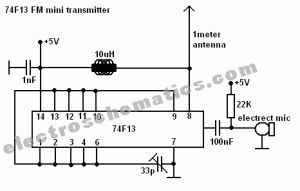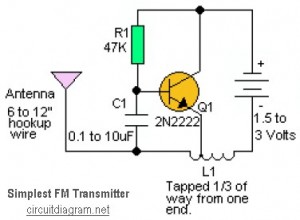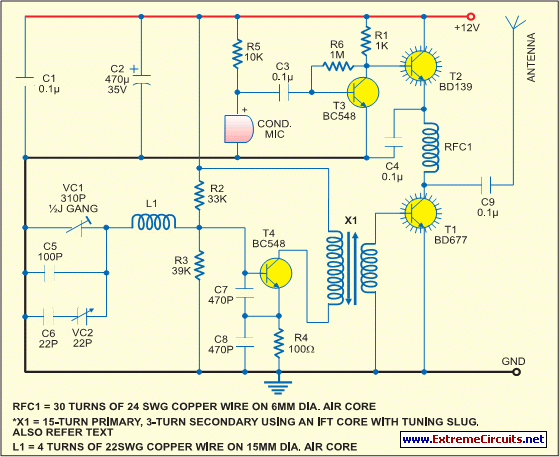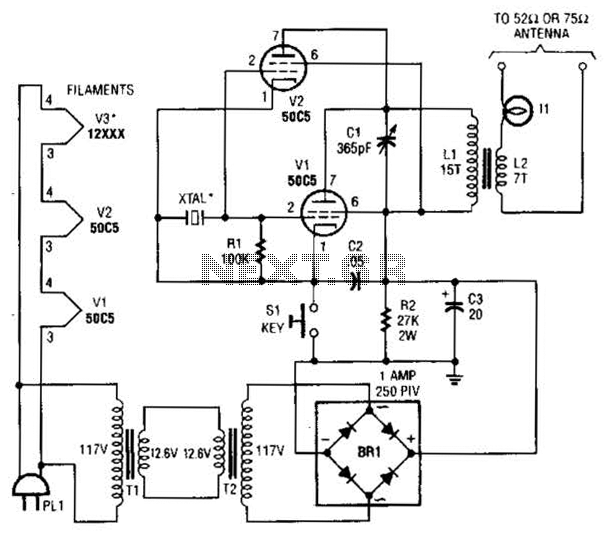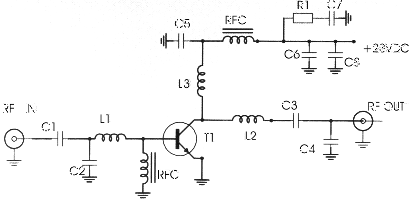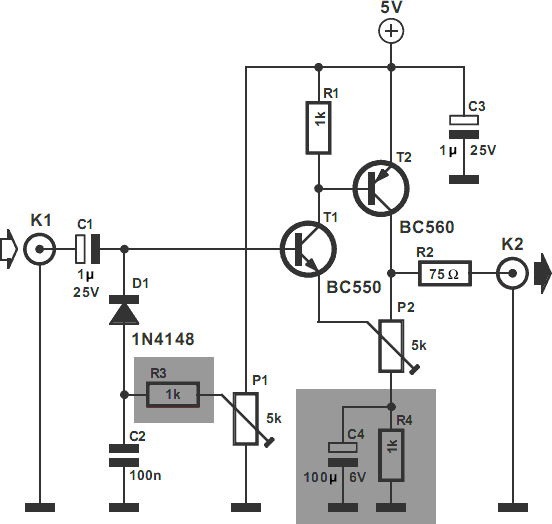
TV Video Transmitter
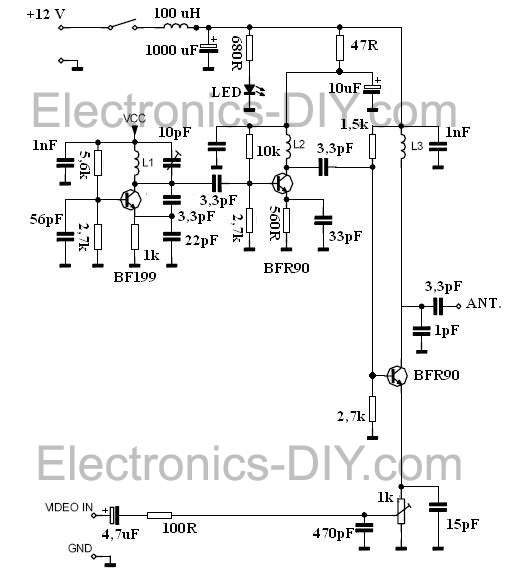
This device is a TV transmitter designed to transmit video signals from various sources, including video cameras, satellite receivers, DVD players, and game consoles. The TV transmitter operates within the frequency range of 470-580 MHz and can be received on UHF channels 21-34. It is capable of radiating signals up to 300 meters when using a 10-20 cm wire antenna. The transmitter requires a voltage supply of 9-15 volts, which can also be provided by 9V batteries. The oscillator circuit utilizes BF199 and BFR90 RF transistors, with the option to extend the range of the transmitter by replacing the BFR90 with 2N3886 transistors.
The TV transmitter circuit comprises several key components that facilitate the transmission of video signals effectively. The heart of the transmitter is the oscillator circuit, which generates the RF signal required for transmission. The BF199 and BFR90 transistors serve as the main active elements in this oscillator circuit, allowing for efficient modulation of the input video signal onto the carrier frequency.
Power supply considerations are critical for the operation of the transmitter. The circuit is designed to operate within a voltage range of 9-15 volts, making it versatile for various power sources, including standard 9V batteries. This flexibility allows for portable applications, enhancing the usability of the transmitter in different environments.
The antenna plays a vital role in signal propagation. A 10-20 cm wire antenna is recommended for optimal performance, allowing the transmitter to radiate signals effectively over distances of up to 300 meters. The choice of antenna length and type can significantly influence the range and quality of the transmitted signal.
For applications requiring extended range, the option to replace the BFR90 transistor with a 2N3886 provides an avenue for improved performance. The 2N3886 transistor is known for its higher power handling capabilities, which can enhance the transmitter's output power and overall range.
In summary, this TV transmitter circuit is a versatile solution for transmitting video signals from multiple sources, with specific design features that allow for efficient operation, adaptability to different power supplies, and options for range extension through component substitution. The overall design emphasizes practicality and performance, making it suitable for various broadcasting applications.This is a TV transmitter for transmitting video of various video sources such as video cameras, Satellite receivers, DVD players, game consoles, etc. TV transmitter`s circuit is working on the 470-580 MHz frequency and can be received on UHF channels 21-34.
TV Video transmitter can radiate as far as 300 meters by using a 10-20 cm wire antenna. TV transmitter requires voltage of 9-15 Volts. However, you can also use a 9v batteries. Oscillator is based around BF199 and BFR90 RF transistors. If needed the range of TV transmitter can be extended by replacing BFR90 with 2N3886 transistors 🔗 External reference
The TV transmitter circuit comprises several key components that facilitate the transmission of video signals effectively. The heart of the transmitter is the oscillator circuit, which generates the RF signal required for transmission. The BF199 and BFR90 transistors serve as the main active elements in this oscillator circuit, allowing for efficient modulation of the input video signal onto the carrier frequency.
Power supply considerations are critical for the operation of the transmitter. The circuit is designed to operate within a voltage range of 9-15 volts, making it versatile for various power sources, including standard 9V batteries. This flexibility allows for portable applications, enhancing the usability of the transmitter in different environments.
The antenna plays a vital role in signal propagation. A 10-20 cm wire antenna is recommended for optimal performance, allowing the transmitter to radiate signals effectively over distances of up to 300 meters. The choice of antenna length and type can significantly influence the range and quality of the transmitted signal.
For applications requiring extended range, the option to replace the BFR90 transistor with a 2N3886 provides an avenue for improved performance. The 2N3886 transistor is known for its higher power handling capabilities, which can enhance the transmitter's output power and overall range.
In summary, this TV transmitter circuit is a versatile solution for transmitting video signals from multiple sources, with specific design features that allow for efficient operation, adaptability to different power supplies, and options for range extension through component substitution. The overall design emphasizes practicality and performance, making it suitable for various broadcasting applications.This is a TV transmitter for transmitting video of various video sources such as video cameras, Satellite receivers, DVD players, game consoles, etc. TV transmitter`s circuit is working on the 470-580 MHz frequency and can be received on UHF channels 21-34.
TV Video transmitter can radiate as far as 300 meters by using a 10-20 cm wire antenna. TV transmitter requires voltage of 9-15 Volts. However, you can also use a 9v batteries. Oscillator is based around BF199 and BFR90 RF transistors. If needed the range of TV transmitter can be extended by replacing BFR90 with 2N3886 transistors 🔗 External reference
